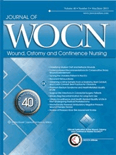
Journal of Wound Ostomy and Continence Nursing
Scope & Guideline
Pioneering research in wound, ostomy, and continence care.
Introduction
Aims and Scopes
- Wound Care Management:
The journal emphasizes research and clinical practices related to the prevention and management of various types of wounds, including chronic and acute wounds, pressure injuries, and surgical wounds. - Ostomy Care:
A significant focus is placed on ostomy management, including the physiological and psychological aspects of living with an ostomy, as well as innovations in ostomy products and patient education. - Continence Nursing:
The journal addresses issues of incontinence, exploring management strategies, patient education, and the psychosocial impacts of incontinence on individuals. - Evidence-Based Practice:
JWOCN promotes evidence-based practice in nursing, encouraging the use of clinical guidelines, systematic reviews, and research findings to improve patient care outcomes. - Interprofessional Collaboration:
The journal highlights the importance of interprofessional collaboration in wound, ostomy, and continence care, showcasing studies and projects that involve teamwork across various healthcare disciplines. - Patient-Centered Care:
A core aim is to emphasize patient-centered approaches in care practices, focusing on improving quality of life and patient satisfaction for individuals with wounds, ostomies, or continence issues.
Trending and Emerging
- Telehealth and Remote Care:
There is a significant increase in the publication of articles related to telehealth, particularly in the context of wound and ostomy care, reflecting the shift towards remote patient management due to the COVID-19 pandemic. - Innovative Technologies:
Emerging themes include the exploration of innovative technologies in wound management, such as digital monitoring tools, advanced materials, and smart devices aimed at improving patient outcomes. - Psychosocial Aspects of Care:
A growing focus on the psychosocial aspects of living with wounds and ostomies is evident, emphasizing the emotional and mental health needs of patients alongside physical care. - Quality Improvement Initiatives:
There is an increased trend in articles that report on quality improvement initiatives aimed at reducing hospital-acquired pressure injuries and enhancing patient safety and care quality. - Health Disparities and Equity:
Emerging discussions around health disparities and the impact of social determinants of health on wound and ostomy care are becoming more prominent, highlighting the need for equitable healthcare practices. - Personalized and Patient-Centered Approaches:
The journal is increasingly focusing on personalized care strategies that cater to individual patient needs, preferences, and circumstances, reinforcing the importance of patient-centered care in nursing practice.
Declining or Waning
- Traditional Wound Dressing Techniques:
There is a noticeable decline in the emphasis on traditional wound dressing techniques as newer technologies and methods, such as negative-pressure wound therapy and advanced wound care products, gain traction. - Basic Patient Education:
The focus on basic patient education regarding wound care and ostomy management appears to be waning, as the journal increasingly publishes articles on advanced educational strategies and technology-enhanced learning. - General Nursing Practices:
There is a reduced emphasis on generic nursing practices that do not specifically address wound, ostomy, or continence care, as the journal narrows its scope to specialized, evidence-based interventions. - Historical Perspectives:
The publication of articles focused on historical perspectives of wound and ostomy care has decreased, shifting towards contemporary issues and innovations in practice. - Single-Discipline Focus:
There is a declining trend in articles that focus solely on one discipline (wound, ostomy, or continence) without integration, as the journal increasingly emphasizes interprofessional approaches and holistic care.
Similar Journals
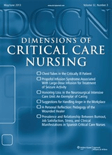
Dimensions of Critical Care Nursing
Elevating Patient Care Through Evidence-Based InsightsDimensions of Critical Care Nursing, published by Lippincott Williams & Wilkins, is a premier journal dedicated to advancing the knowledge and practices within the fields of critical care and emergency nursing. With a distinguished history dating back to 1982, this journal plays a vital role in disseminating cutting-edge research, clinical advancements, and educational resources aimed at enhancing patient care in high-stakes environments. The journal is ranked in the Q2 quartile for both Critical Care Nursing and Emergency Nursing, reflecting its significant impact on the nursing field, with Scopus rankings placing it at #11 in Critical Care Nursing and #14 in Emergency Nursing. Targeting a multidisciplinary audience of researchers, clinicians, and students, the journal serves as a critical platform for discussions surrounding innovative patient care strategies, evidence-based practices, and emerging trends in critical nursing. Although it is not an open-access journal, it provides valuable insights that are essential for shaping the future of nursing practice. Stay informed on the latest research and contribute to the evolving landscape of critical and emergency care through Dimensions of Critical Care Nursing.
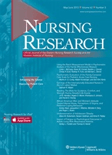
NURSING RESEARCH
Transforming healthcare through innovative nursing research.Nursing Research, published by Lippincott Williams & Wilkins, is a prestigious academic journal dedicated to advancing the field of nursing through rigorous research and evidence-based practice. With an ISSN of 0029-6562 and an E-ISSN of 1538-9847, this journal has been a cornerstone of nursing scholarship since its inception in 1952. Currently ranked in the Q2 category for Medicine (miscellaneous) and in the Q1 category for Nursing (miscellaneous) as of 2023, Nursing Research is recognized for its high-quality contributions to the field and is ranked 38th out of 139 in General Nursing within Scopus. The journal offers essential insights and a forum for the latest research, enhancing clinical practices and informing policy decisions. Although it does not provide open access, it remains highly respected among researchers, professionals, and students alike, serving as an indispensable resource for those dedicated to improving patient care and advancing nursing science. For more information and to access articles, visit Nursing Research.
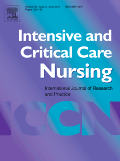
Intensive and Critical Care Nursing
Advancing critical care through rigorous research.Intensive and Critical Care Nursing is a premier peer-reviewed journal published by Elsevier Science Ltd, dedicated to advancing the field of critical care nursing through high-quality research, innovative practice, and critical analysis. With an impressive impact factor, this journal is recognized as a leading resource in Critical Care Nursing, holding the esteemed Q1 quartile designation and ranking first among 27 journals in its category, placing it at the 98th percentile. Since its inception in 1992, the journal has been committed to fostering an interdisciplinary dialogue among researchers, clinicians, and educators, ultimately aiming to improve patient outcomes in critical care settings. While currently not offering open access options, the journal is highly accessible through leading academic databases, ensuring that cutting-edge research reaches its intended audience. Explore the latest findings and developments in critical care nursing that shape and influence practice across the globe.
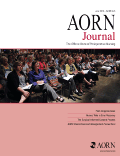
AORN JOURNAL
Advancing Knowledge, Elevating Care.AORN JOURNAL, a reputable publication in the field of Medical and Surgical Nursing, has been at the forefront of nursing education and practice since its inception in 1963. Published by WILEY, this peer-reviewed journal serves as an essential resource for nurses, educators, and healthcare professionals seeking to enhance their knowledge and skills in perioperative care. With an impressive ranking of 15th out of 26 in its category according to Scopus, and a Q2 rating in the 2023 category quartiles, the AORN JOURNAL consistently provides high-quality research, innovative practices, and evidence-based guidance. While currently not an open-access journal, it offers valuable insights and practical solutions to complex challenges in surgical settings, making it a crucial tool for advancing the nursing profession. The journal's commitment to fostering excellence in patient care continues to empower professionals and students alike, ensuring they stay at the leading edge of medical knowledge and practice.
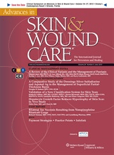
Advances in Skin & Wound Care
Fostering Collaboration in Advanced Skin Care Research.Advances in Skin & Wound Care, published by LIPPINCOTT WILLIAMS & WILKINS, is a leading journal in the field of dermatology and advanced nursing dedicated to the dissemination of cutting-edge research and clinical practices focused on skin and wound management. With an ISSN of 1527-7941 and E-ISSN 1538-8654, this journal provides a vital platform for researchers, clinicians, and educators to explore evidence-based approaches that enhance patient outcomes. Operating since 2000 and converging through 2024, it has earned notable recognition within the academic community, holding a Q2 ranking in Advanced and Specialized Nursing and a Q3 in Dermatology as of 2023, alongside a respectable Scopus impact featuring ranks in the 70th and 51st percentiles respectively. Although the journal does not currently offer open access options, it remains an essential resource for professionals and students striving to advance their knowledge in skin and wound care, fostering collaboration and innovation in these critical areas of health care.
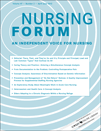
NURSING FORUM
Empowering Nursing Excellence through Innovative Research.NURSING FORUM, published by Wiley-Hindawi, is a premier journal dedicated to advancing the knowledge and practice of nursing across diverse contexts. With an ISSN of 0029-6473 and E-ISSN 1744-6198, this esteemed journal has been a vital source of scholarly communication since its inception in 1961, serving researchers, practitioners, and educators in the nursing field. Recognized for its impactful contributions, it holds a prestigious Q1 ranking in Nursing (miscellaneous) and ranks #18 out of 139 in Scopus' General Nursing category, placing it in the top 87th percentile of its field. With its publication continuity from 1961 to 2024, NURSING FORUM promotes innovative research, evidence-based practices, and critical discourse essential for the nursing profession. This journal not only provides access to cutting-edge studies but also fosters a collaborative platform for healthcare professionals and academics to engage and share insights. Whether you are a seasoned researcher or a nursing student, NURSING FORUM is your essential gateway to the latest advancements and discussions that shape the future of nursing.

WOUNDS-A COMPENDIUM OF CLINICAL RESEARCH AND PRACTICE
Empowering Professionals with Cutting-Edge InsightsWOUNDS - A Compendium of Clinical Research and Practice is an esteemed journal, published by H M P Communications, that serves as a vital resource for researchers, clinicians, and students dedicated to the field of wound care and management. Since its inception in 1996, the journal has established itself as a significant platform for disseminating original research and innovative clinical practices related to wound healing, making substantial contributions to the disciplines of Medical and Surgical Nursing, as well as Medicine and Surgery. With a current impact factor that categorizes it in Q2 and Q3 quartiles for various relevant fields, WOUNDS enjoys a robust academic reputation underscored by its Scopus ranking - being among the top 30% in Nursing and demonstrating a noteworthy presence in Medicine and Surgery. The journal continues to foster knowledge sharing and collaboration among professionals, enhancing patient care outcomes in clinical settings. Researchers and practitioners alike will find value in its rigorously peer-reviewed articles that not only inform clinical practice but also drive forward the science of wound management.
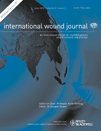
International Wound Journal
Leading the way in evidence-based wound healing research.The International Wound Journal, with ISSN 1742-4801 and E-ISSN 1742-481X, is a leading peer-reviewed journal published by WILEY in the United Kingdom, emphasizing cutting-edge research and clinical advances in the domains of Dermatology and Surgery. Having transitioned to an Open Access model since 2021, this journal fosters wider dissemination and accessibility of significant findings in wound healing and management, elevating knowledge sharing among healthcare professionals and researchers alike. With an impressive impact factor and categorized as a Q1 journal in both the fields of Dermatology and Surgery for 2023, it ranks in the top echelons of its discipline—#106 out of 551 in Medicine Surgery and #33 out of 142 in Medicine Dermatology according to Scopus. By providing a platform for high-quality, evidence-based research, the International Wound Journal plays a crucial role in advancing clinical practice and improving patient outcomes, making it an indispensable resource for the global medical community over its anticipated run from 2004 to 2024.
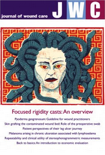
Journal of Wound Care
Empowering Professionals in Wound ManagementJournal of Wound Care is a leading scholarly publication in the field of wound management and nursing, published by MA HEALTHCARE LTD. Established in 1995 and continuing through to 2024, this journal holds a Q2 category ranking in both Fundamentals and Skills and Nursing (Miscellaneous) as of 2023, reflecting its significant contribution to the academic and practical aspects of wound care. With impressive Scopus rankings—#4 out of 15 in Nursing Fundamentals and Skills and #15 out of 45 in Nursing (Miscellaneous)—the journal stands as a reputable source of peer-reviewed research, case studies, and reviews that enhance clinical practice and inform educational strategies. As a non-open-access journal, it offers curated content that is readily accessible to professionals aiming to stay at the forefront of advancements in wound care. Journal of Wound Care is essential reading for researchers, practitioners, and students dedicated to improving patient outcomes in wound management and care.
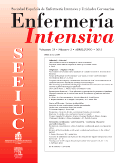
Enfermeria Intensiva
Elevating Patient Care with Specialized Nursing ResearchEnfermeria Intensiva, published by Elsevier Science Inc, is a highly regarded journal in the fields of Advanced and Specialized Nursing as well as Critical Care and Intensive Care Medicine. With an impressive track record spanning from 1994 to 2024, this journal serves as a vital resource for researchers, healthcare professionals, and students dedicated to enhancing the quality of patient care in critical settings. It holds a coveted Q2 ranking in multiple nursing categories as of 2023, reflecting its influence and contribution to the ongoing discourse in nursing practices. Although currently not an open access journal, it continues to provide intricate insights into both fundamental skills and specialized techniques essential in intensive nursing care. By bridging research and practical application, Enfermeria Intensiva plays a pivotal role in advancing knowledge and improving outcomes in critical care environments.